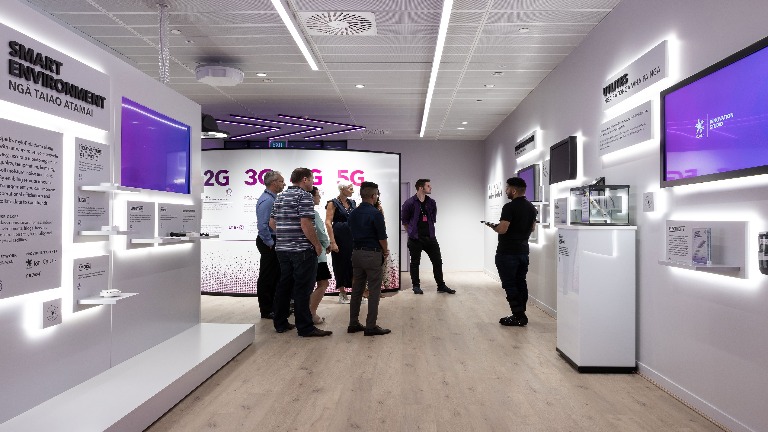Please configure
Spark launches Innovation Studio to help Kiwi businesses harness the power of emerging technology
As New Zealand continues to respond to the challenges of COVID-19 and prepares its transition to a low-carbon economy, Spark has today launched a new Innovation Studio that will support Kiwi businesses to identify how emerging technologies like the Internet of Things (IoT) and 5G can help them adapt, transform and grow.
The Spark Innovation Studio will be the first place in New Zealand where businesses can test technology solutions on all networks (4G, 5G, Cat M1, NB IoT, LoRaWAN) and co-create their own solutions alongside some of the best technology engineers and experts New Zealand has to offer.
Spark’s IoT Lead Tony Agar said the Innovation Studio aims to bridge the gap between understanding and action by demystifying emerging technology and showcasing real-life examples of how it can help solve business challenges.
“When you consider the challenges we are facing as a nation, from COVID-19 to climate change to lagging productivity, it is clear that technology is going to play an important enabling role in helping us adapt. As one example, research cited by the World Economic Forum[1] has shown digital technology could help cut global carbon emissions by 15 per cent.
“We know New Zealanders and our business community understand the value of digitisation, but often struggle to move from insight to action. That is where the Innovation Studio comes in – it is hands on, practical and collaborative and a place where businesses can learn how to become more productive, resilient and sustainable through technology.”
The Innovation Studio features four interactive zones that showcase how emerging technology can help key sectors such as agriculture, aquaculture, utilities, transport, logistics, councils, government and health and safety to benefit from the digitisation of their business operations.
The Utilities Zone shows how combining end-to-end connectivity with IoT technology can allow utilities businesses to glean valuable insights into the usage and management of resources, from generation of power or flow of water, to energy consumption in a home. The IoT solutions displayed in this zone can create resource usage efficiencies, as well as environmental benefits such as cleaner waterways.
To bring this zone to life, fast growing New Zealand IoT solutions provider, Adroit, showcases its recent innovation in partnership with the local aquaculture industry, a data-buoy nicknamed ‘Murray’ that monitors the quality of the water. Murray has been deployed to provide real-time feedback on salinity and temperature at the Westpac Mussel Farm in the Firth of Thames using Spark’s Cat-M1 network.
The Smart Environments Zone explores how installing IoT sensors in urban and rural environments can improve the way utilities and services are operated. It showcases how real-time data insights collected from IoT sensors are helping decision makers to plan for the future, from aiding city planners to construct smarter urban environments, to helping farmers operate their farms to reduce their impact on the environment.
Qrious, in partnership with Spark and Auckland Transport, has created a pilot for urban street maintenance, integrating data sources from Wynyard Smart Street IoT devices like connected bins and lights, into a holistic data dashboard. Key information can be viewed in augmented reality form via a Hololens headset so field workers can easily access critical information. The dashboard displays strategic insights like trend analysis over time, anomaly detection and predictive modelling. For example, bin emptying trips and routes can be optimised, making for more sustainable street maintenance when multiplied at scale.
The Emerging Tech Zone is a look into the future where IoT and 5G intersect and bring to life solutions people may think are impossible – but are in fact reality. From immersive 5G powered experiences that cut out the need for travel, intelligent lighting that uses sensors to replicate natural light and energy saving efficiencies, and Ericsson’s Industry 4.0 augmented reality demonstration which shows how blending technologies – using real time data from connected IoT devices – can make autonomous business operations possible, from a drone managed flower farm to an autonomous factory.
With an ambition to progress their net carbon reduction targets by reducing logistics freight, Toyota New Zealand has harnessed 5G to create an immersive VR experience for customers’ buying journey, virtually bringing thousands of car models and customization options to prospective buyers through a VR headset.
The Asset Management Zone showcases recent developments to one of the first IoT applications to be broadly adopted by New Zealand businesses. IoT asset tracking devices are increasingly used by businesses to monitor valuable assets and gather insights into how they are being used, enabling optimisation and driving productivity gains and operational efficiencies.
Within the Innovation Studio, Spark will showcase a range of usage applications, from end-to-end fleet management, in partnership with Blackhawk and Digital Matter, to end-to-end asset visibility using RFID tagging via Zebra, with valuable applications for retail, e-commerce, manufacturing, transportation, logistics, healthcare and the public sector.
Spark has selected Amazon Web Services (AWS) as the cloud provider for its new Innovation Studio. Together, Spark and AWS will explore and build IoT solutions for New Zealand companies.
Nick Walton, Managing Director for Commercial Sector at Amazon Web Services (AWS) in New Zealand says, “We see New Zealand as a hub of innovation, and it’s exciting to work with Spark to explore our shared vision of IoT and its role in driving the digital transformation in New Zealand. Working with the Spark Innovation Studio, we hope to give local businesses a hands-on opportunity to explore the uses and benefits of IoT within our cloud environment, in a way that is easy, accessible and efficient.”
Spark’s Innovation Studio is now open for New Zealand businesses, councils and government to explore how technology solutions can enhance their productivity, improve their sustainability profile or accelerate the digitisation of their operations. To book a tour or find out more information, visit www.spark.co.nz/iot/innovation-studio.
ENDS
Notes to editor:
See here for a video of Adroit’s new water quality monitoring device ‘Murray’.
Spark identified IoT as a future market in the release of its 3-year strategy to the market in 2020. Spark is already in the market with a range of end-to-end solutions and its ambition is to become the New Zealand IoT platform partner of choice by FY23. During the first half of FY21 Spark’s IoT connections grew 65%.
Each zone of the Spark Innovation Studio features a number of examples of IoT technologies:
Smart environments
- Spark’s IoT Visualization layer works with IoT networked sensors to provide easy, accurate monitoring of air quality, temperature, humidity, soil moisture, noise and light from an easy-to-use dashboard on a computer or mobile phone.
- Qrious offers data platforms, solutions, models, and dashboards to combine data from a range of IoT sensors into one place to provide a complete picture of an environment to support operational and strategic decisions.
- Adroit’s latest monitoring technology provides wireless real-time monitoring and control solutions for water, air, soil and weather quality to ensure regulatory compliance, operational efficiency and maintenance of health and safety on site.
- Parkable’s Smart Parking technology uses advanced ground-mounted sensors connected via the Spark network to provide real-time visualisation of parking availability so staff, tenants and visitors can plan their commutes for effortless parking.
- NB Smart Cities’ remotely operated IoT-connected Smart Lights can be dimmed and brightened as conditions and demands dictate, as well as monitor pedestrian and cycle traffic and provide CCTV to keep people moving swiftly and safely.
- Smart Sense’s Smart Waste IoT connected sensors detect when rubbish bins require collection, so rubbish trucks are only on the road when needed to prevent unhygienic and unsightly overflow.
- Spark’s asset and fleet tracking solution which utilizes Digital Matter devices, and the Blackhawk dashboard provides visibility of high value assets and vehicles. This data could help improve asset utilization, promote staff safety, reduce costs, and save time.
- Zebra’s latest technology provides real-time tracking and positioning of indoor assets to allow for automation, analysis and streamlining of operations to boost efficiency and workforce productivity.
- Intellihub’s smart meters help enable innovative Energy solutions. Their meters transmit timely and informative data, which can be used by customers to manage their energy usage plus energy retailers and distribution companies to improve the services delivered, which includes creative customer offers and managing energy generation more effectively to reflect increased usage of electric vehicle charging and solar panels in homes around New Zealand.
- Novii have helped create innovative and intelligent lighting that will sense and monitor the natural light levels outside the building and replicate it inside. The smart lighting senses when people move around the studio enabling energy saving efficiencies by only lighting areas when needed.
- Toyota New Zealand have harnessed 5G and Edge Computing to create an immersive experience for their buying journey. With so many Toyota models, variants and colours, they can now demonstrate a full range when a specific demonstrator vehicle is not available at a customer’s local Toyota Store.
- Ericsson showcases the potential of Industry 4.0 – a vision for how businesses could benefit from the convergence of augmented reality, IoT and 5G. The augmented reality demonstration shows how blending technologies – using real time data from IoT devices and connectivity to mobile networks embedded in key business assets – can make autonomous business operations possible, from a drone managed flower farm to an autonomous factory.

Ellie Cross
+64 22 6300665 | Ellie.Cross@spark.co.nz
Please configure








